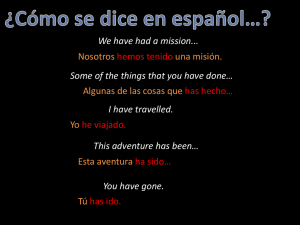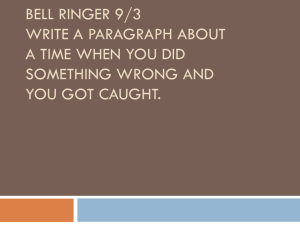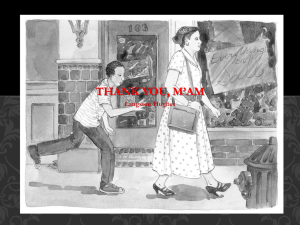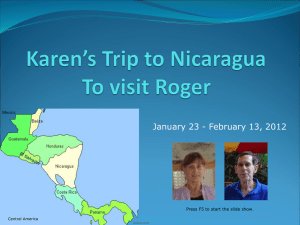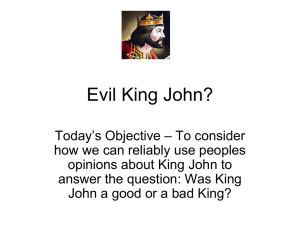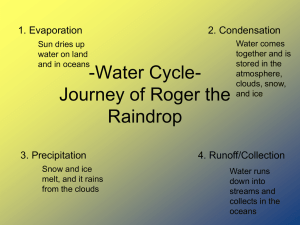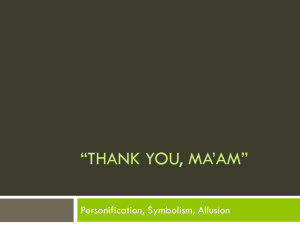Roger Morsa Focus op een bijzondere Inlichtingen en Actie Agent
advertisement
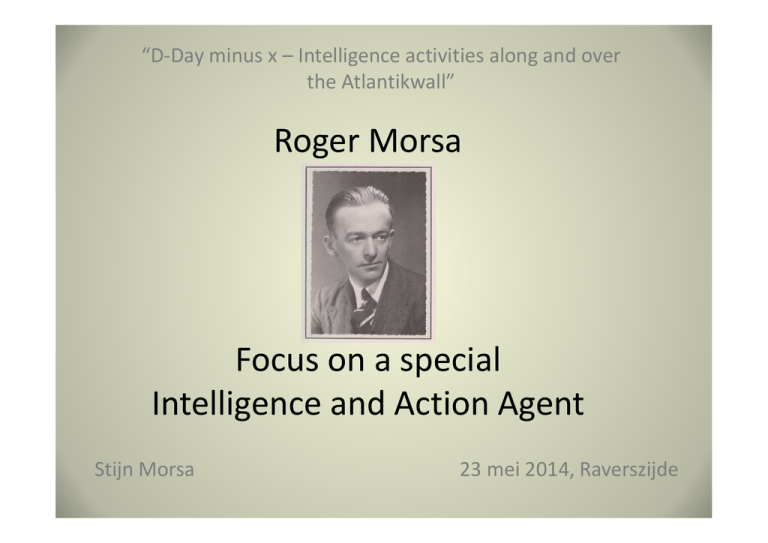
“D‐Day minus x – Intelligence activities along and over the Atlantikwall” Roger Morsa Focus on a special Intelligence and Action Agent Stijn Morsa 23 mei 2014, Raverszijde OVERVIEW 1. Introduction 2. The build up to World War II a) Youth b) Professional career c) Military career 3. Roger Morsa and World War II a) Mobilisation and capitulation b) Life as a secret agent (ARA) c) A major problem emerges d) End of WWII 4. Appreciation 5. End 1. Introduction • Personal perspective on growing up with the legacy of Roger Morsa: o Unaware of his achievements during WW II for much of my youth o Good and fun relationships with my godmother (his wife), uncles and aunts o Only some stories about Roger Morsa as a father were mentioned o As teenager his achievements slowly got more attention, including mine o So, most info I used now comes from articles and his personal documents 1. Introduction 2. The build up to World War II a) Youth • Born on 15 July 1909 in La Sarte‐à‐Ben, Ben‐ Ahin (7 km from Huy and 43 km from Liège), son of Gaston Morsa and Marie Fourneau • Grows up in the rural village La Sarte‐à‐Ben with perhaps already a hint of going further than his ancestors. • Loses his mother at age 15 and his father at age 19 • Graduates with great distinction at 18 from the Ecole Moyenne de l’Etat pour garçons (section administrative) in Huy on 15 July 1927 1. Introduction 2. The build up to World War II a) Youth b) Professional career • 18 November 1927 he passes exam to work at the land registry of Bruges • Starts working at the land registry as technician on 1 Janyary 1928 • Not so work related: meets a girl from Zonnebeke (near Ypres) and marries her the 22nd of august 1931, together they’ll have 5 children • After courses and exams obtains degree of surveyor (23/12/1936) • He becomes head‐surveyor in september 1942 • His superior, Antoine Leclercq, described him as very intelligent man with excellent drawing skills 1. Introduction 2. The build up to World War II a) Youth b) Professional career c) Military career • Enters military service at age 20 (15 October 1929), 1° regiment • Ends his service one year later as a Sergeant • Joins military reserve force on 25 August 1932 and is promoted (after exams) via 2nd Lieutenant to Lieutenant on 26 march 1937, in the 4° regiment Military career: 1. Introduction 2. The build up to World War II 3. Roger Morsa and World War II a) Mobilisation and capitulation: • 18 october 1939 called to service as intelligence officer for the 33° en 34° regiment, later for the 13° Infantery Division • Invasion of Belgium on 10 May 1940 followed by the 18 Days’ Campaign • Belgian surrender, by king Leopold III, on 28 May 1940 • Roger Morsa becomes prisonar of war • 11 June 1940: discharge from army/prisonar of war • Almost immediaty back to work in land registry 11 June 1940, discharge from army/prisonar of war: 1. Introduction 2. The build up to World War II 3. Roger Morsa and World War II a) Mobilisation and capitulation (18 Days’ Campaign) b) Life as an intelligence and action agent (ARA) • Enlistment in the Secret Service in december 1940 as an intelligence and action agent or ARA (Agent de Renseignements et d’Action) • In march 1942 he is recruited, as LL8000, by the secret service ZIG of Christian Jooris, with doctor Pierre Glorieux as his superior • Christian Jooris is 1 of 4 brothers whom all started a secret service • Only following persons were aware of his secret activities: his closest colleague (also ZIG) Georges Vandenberghe, his superior Antoine Le Clercq and last but not least his wife Maria Coemelck • How the german occupier started to use the copymachine: o Festungs Nachschub Stab 5, drawing security plans for the Oberkommando, uses a building in the Noordzandstraat in Bruges o From march 1942 the Organisation Todt, planning the construction of the Atlantikwall, confiscates and uses the Benedictine Abbey of Zevenkerken in St‐Andries Bruges o These two and other german services need to copy their plans and at first they use copymachine of the “Bouwbedrijf” (of several construction enterprises) o Because of lack of confidence in private enterprise the german occupier wants to use copymachine of a State organisation o Germans start using the copymachine of the Land Registry of Bruges from approximetaly March 1942 Procedure: • plans kept in safe in situ • if copies are needed the plans are transported under heavy guard to the Land Registry • under strict conditions the plans are copied according to order Date Applicant Paper, delivered by Present during copying Nr of copies Content • Finding an modus operandi o At first only german soldiers or staff (Gefreiter) were allowed to work with the copymachine or to be present during copying o Roger Morsa makes sure the copying machine malfunctions once in a while o Germans order him to repare the machine o Roger Morsa and his colleague Georges Vandenberghe gain german confidence and are tolerated during the copying o Roger Morsa optimizes copying machine and adds waste bag in which not only waste disappears but also 1 copy of the germans plans o Although everything, including number of copies, is rigorously checked by the Germans they fail to notice that 1 extra copy is made Land survey Festungs Nachschub Stab 5 Dr. Pierre Glorieux Home Roger Morsa • The journey to London of that 1 extra copy... o Roger Morsa goes to dr. Pierre Glorieux (ZIG) to be treated of an imagenary stomach ulcer, instead the plans were microfilmed o Roger Morsa or another agent bikes with the microfilm in the framework of the bike to Christian Jooris (ZIG) in Wildenburg, Wingene Organisation Todt, Abbey Zevenkerken • The journey of that 1 extra copy continues... o Thanks to the networks of 2 other brothers of Christian Jooris the microfilm gets transported to: The Ardennes, if urgent, to be picked up by RAF aeroplane (Westland Lysander): services by network B.B. = Brise and Botte = Emmanuel Jooris and Joseph Romainville Via France to Spain to be picked up by RAF aeroplane: services by network Bayard of Antoine Jooris and Auguste Dubuisson RAF Around 8 km by bike RAF Christian Jooris, Wingene • Around 500 plans are copied and transferred to Allies in London Some examples of plans: Cannot be taken along in “HKL (?)” or not to fall in enemy hands Edition may 1943 Some more examples... References to explanatory text Brise and Botte Also other info and explanation of the plans were sent to London: Plans of minefields See plans Mined bridges V2 launching facility, Kraftwerk Nord West Trenches and bunkers along canal Remarks about the intelligence services Coded message from ? 1. Introduction 2. The build up to World War II 3. Roger Morsa and World War II a) Mobilisation and capitulation b) Life as an intelligence and action agent (ARA) c) A major problem emerges: • In July 1943 a courrier of ZIG gets caught by the Germans in the South of France (le Midi) carrying the micro‐films • The Germans are shocked to find the copies of their secret military plans and the Geheime Feldpolizei starts a thorough investigation • Plans originate from Festungs Nachschub Stab 5 and everybody involved in drawing, transport and copying is screened • Register of Land Registry is most probably confiscated for analysis • On 21 July 1943 five members of Stab 5 and Roger Morsa are arrested and interrogated by the Geheime Feldpolizei (GFP) on several occasions in Bruges and Ghent • Roger Morsa is depicted by the GFP as a simple, law abiding and not so clever man, and is marked as trustworthy • Roger Morsa is cleared and asked to keep quiet about this whole affair • Afterwards he is asked to point out who of the five members of german staff is most likely to be responsible of treason (Landesverrat) • He points out the Austrian Ernst Johan Kisch who seems to have been in possesion of Dollars (bribes of companies for construction Atlantikwall?) • This puts Roger Morsa in a moral conflict which troubles him so much he feels sick and unable to return to the Land Registry (for several weeks) • The Geheime Feldpolizei is, after further questioning, convinced that Ernst Johann Kisch is guilty of treason and he is put on trial • 7 January 1944: Roger Morsa and Georges Vandenberghe are witnesses during the trial • Ernst Johann Kisch is convicted for Landesverrat and sentenced to death • 1 day before liberation of Bruges (11 September 1944) this man of 47 years and father of 3 children is executed in Steenbrugge • Roger Morsa resumes work after several weeks in which he sought consolation and in which résistance members addressed to him the importance of his work as a secret agent • The Germans keep on using the Land Registry for copying and after his return, Roger Morsa is again allowed to be present during copying • The steady flow of copied plans resumes it’s way to London untill the end of WW II 1. Introduction 2. The lead‐up to World War II 3. Roger Morsa and World War II a) Mobilisation and capitulation b) Back to work c) Life as an intelligence and action agent (ARA) d) End of WWII • 6 June 1944 = D‐Day: landings of Allied troops in Normandy • 2 september 1944: first american troops cross belgian border close to Chimay, Ardennes • 3 september 1944: Mons, Brussels and Aalst already liberated • First canadian troops enter St‐Andries (Bruges) in the evening of 7 september • The abbay of Zevenkerken first liberated on 8 september • St‐Andries and Bruges completely liberated on 12 september 1944 • Belgium completely liberated 4 February 1945 • 2 September 1945 End of World War II 24 August 1944: last Wehrmacht entry 30 August 1944: very last entry • After liberation of Bruges Roger Morsa probably further informs Allied troops about german defensive structures as two of these documents can prove (official pass and exemption from security restrictions) • Last document exempts Roger Morsa of remobilisation and states he can continue his profession at the Land Registry 1. Introduction 2. The lead‐up to World War II 3. Roger Morsa and World War II 4. Appreciations: • Starting at the end of 1945 a reverse stream of correspondence starts, mainly to recognize the importance of his work as a secret agent • 9 9 9 9 9 Moving up ranks: 13 August 1946: agent of 2° category (Captain) starting from 15 March 1944 26 September 1946: agent of 4° category (Adjudant) starting from 15 July 1942 31 March 1947: agent of 3° category (Lieutenant) starting from 1 Oktober 1942 2 April 1948: captain in the military reserve force 26 December 1949: captain‐commander in the military reserve force • Roger Morsa is awarded numerous decorations • Several belgian decorations: o 26/04/1946: Chevalier de l’Ordre de Léopold avec Palme et Attribution de la Croix de Guerre 1940 avec Palme o 23/08/1946: Médaille Commémorative de la guerre 1940‐1945 o 15/11/1946: Chevalier de l’Ordre de la Couronne o 28/01/1947: Médaille de la Résistance • Several international decorations: o 21/05/1946: Médaille Commémorative française de la guerre 1939‐1945 o 10/07/1946: Medal of Freedom (USA) o 06/03/1948: Honorary Member of the Most Excellent Order of the British Empire, Military Division 1. Introduction 2. The build up to World War II 3. Roger Morsa and World War II 4. Appreciation 5. End • Despite his achievements during WW II and resulting decorations he stays low‐profile, so even after the end of the war few people know about his life as an intelligence and action agent • Unfortunately he can only enjoy five years in a liberated Belgium/Europe and dies of lungcancer on 11 july 1950 • Left behind with his memory and legacy are his wife Maria and children Reine, Guy, Robert, Marcel and René Used sources: • private collection of Morsa family (now in exposition) • Biographie Nationale: article about Morsa by Nicolas Huyghebaert • De Kroniek van Sint‐Andries: “de Bevrijding van Sint‐Andries” • Book: Brugge Die Scone • Wikipedia for some background information Acknowledgement: • BISC for organising this conference • Robin Libert for inviting me to talk about my grandfather • Dany Cologni for his enthousiasm and help • My family for their support and presence Questions or remarks? • now or later via stijn.morsa@telenet.be
